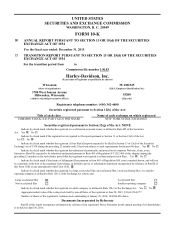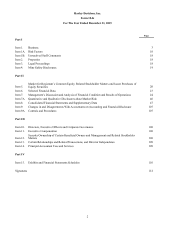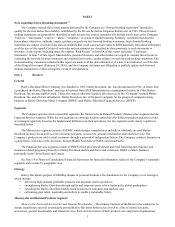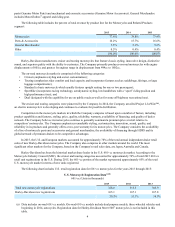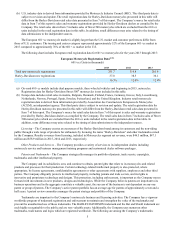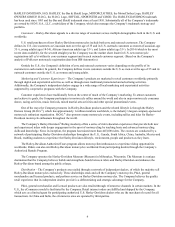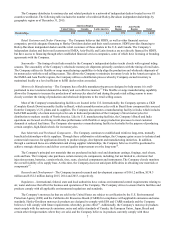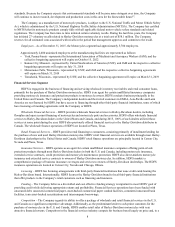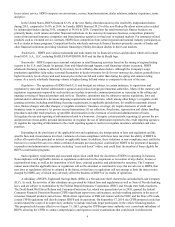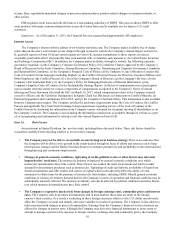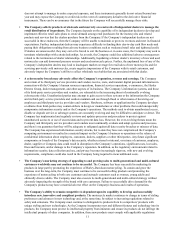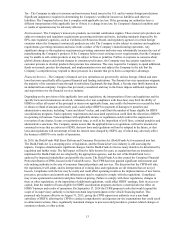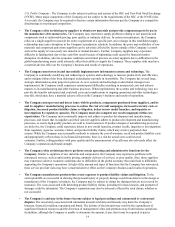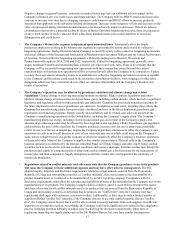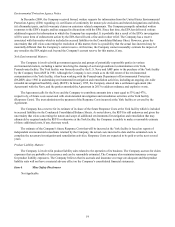Harley Davidson 2015 Annual Report Download - page 9
Download and view the complete annual report
Please find page 9 of the 2015 Harley Davidson annual report below. You can navigate through the pages in the report by either clicking on the pages listed below, or by using the keyword search tool below to find specific information within the annual report.9
lesser extent, service. HDFS competes on convenience, service, brand association, dealer relations, industry experience, terms
and price.
In the United States, HDFS financed 62.2% of the new Harley-Davidson motorcycles retailed by independent dealers
during 2015, compared to 56.8% in 2014. In Canada, HDFS financed 39.2% of the new Harley-Davidson motorcycles retailed
by independent dealers during 2015, compared to 34.0% in 2014. Competitors for retail motorcycle finance business are
primarily banks, credit unions and other financial institutions. In the motorcycle insurance business, competition primarily
comes from national insurance companies and from insurance agencies serving local or regional markets. For insurance-related
products such as extended service contracts, HDFS faces competition from certain regional and national industry participants as
well as dealer in-house programs. Competition for the wholesale motorcycle finance business primarily consists of banks and
other financial institutions providing wholesale financing to Harley-Davidson dealers in their local markets.
Trademarks – HDFS uses various trademarks and trade names for its financial services and products which are licensed
from H-D U.S.A., LLC, including HARLEY-DAVIDSON, H-D and the Bar & Shield logo.
Seasonality – HDFS experiences seasonal variations in retail financing activities based on the timing of regional riding
seasons in the U.S. and Canada. In general, from mid-March through August, retail financing volume is greatest. HDFS
wholesale financing volume is affected by inventory levels at Harley-Davidson dealers. Although the Company's surge
production capabilities help reduce seasonal fluctuations in dealer inventory levels for new motorcycles, dealers generally have
higher inventory levels of new and used motorcycles in the late fall and winter than during the spring and summer riding
season. As a result, wholesale financing volume is higher during fall and winter as compared to the rest of the year.
Regulation – The operations of HDFS (both U.S. and foreign) are subject, in certain instances, to supervision and
regulation by state and federal administrative agencies and various foreign governmental authorities. Many of the statutory and
regulatory requirements imposed by such entities are in place to provide consumer protection as it pertains to the selling and
ongoing servicing of financial products and services. Therefore, operations may be subject to various regulations, laws and
judicial and/or administrative decisions imposing requirements and restrictions, which among other things: (a) regulate credit
granting activities, including establishing licensing requirements, in applicable jurisdictions; (b) establish maximum interest
rates, finance charges and other charges; (c) regulate customers’ insurance coverage; (d) require disclosure of credit and
insurance terms to customers; (e) govern secured transactions; (f) set collection, foreclosure, repossession and claims handling
procedures and other trade practices; (g) prohibit discrimination in the extension of credit and administration of loans;
(h) regulate the use and reporting of information related to a borrower; (i) require certain periodic reporting; (j) govern the use
and protection of non-public personal information; (k) regulate the use of information reported to the credit reporting agencies;
(l) regulate the reporting of information to the credit reporting agencies; and/or (m) regulate insurance solicitation and sales
practices.
Depending on the provisions of the applicable laws and regulations, the interpretation of laws and regulations and the
specific facts and circumstances involved, violations of or non-compliance with these laws may limit the ability of HDFS to
collect all or part of the principal or interest on applicable loans. In addition, these violations or non-compliance may entitle the
borrower to rescind the loan or to obtain a refund of amounts previously paid, could subject HDFS to the payment of damages
or penalties and administrative sanctions, including “cease and desist” orders, and could limit the number of loans eligible for
HDFS securitization programs.
Such regulatory requirements and associated supervision could limit the discretion of HDFS in operating its business.
Noncompliance with applicable statutes or regulations could result in the suspension or revocation of any charter, license or
registration at issue, as well as the imposition of civil fines, criminal penalties and administrative sanctions. The Company
cannot assure that the applicable laws or regulations will not be amended or construed in ways that are adverse to HDFS, that
new laws or regulations will not be adopted in the future, or that laws or regulations will not attempt to limit the interest rates
charged by HDFS, any of which may adversely affect the business of HDFS or its results of operations.
A subsidiary of HDFS, Eaglemark Savings Bank (ESB), is a Nevada state thrift chartered as an Industrial Loan Company
(ILC). As such, the activities of this subsidiary are governed by federal laws and regulations as well as State of Nevada banking
laws, and are subject to examination by the Federal Deposit Insurance Corporation (FDIC) and Nevada state bank examiners.
The Dodd-Frank Wall Street Reform and Consumer Protection Act, which was passed into law in 2010, granted the federal
Consumer Financial Protection Bureau (CFPB) significant supervisory, enforcement, and rule-making authority in the area of
consumer financial products and services. While direct supervision of ESB will remain with the FDIC and the State of Nevada,
certain CFPB regulations will directly impact HDFS and its operations. On September 17, 2014, the CFPB proposed a rule that
would expand the scope of its supervisory authority to include non-bank larger participants in the vehicle financing market.
This proposed rule became effective on August 31, 2015, giving the CFPB supervisory authority over a non-bank subsidiary of
HDFS, allowing the CFPB to conduct comprehensive and rigorous on-site examinations that could result in enforcement

